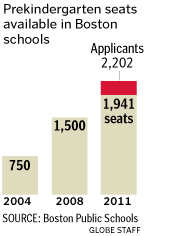Top Chef trots into taboo territory
"Producers of the competitive culinary TV show Top Chef Canada galloped headlong into an internet outcry after news spread about an upcoming episode's focus on horse meat as an ingredient. In the challenge, scheduled to air on May 16th on Food Network Canada, contestants were required to cook traditional French dishes, including both foie gras (also a controversially-obtained food) and horse.
HT: Joshua Gans (the Canadian professor:)
"Producers of the competitive culinary TV show Top Chef Canada galloped headlong into an internet outcry after news spread about an upcoming episode's focus on horse meat as an ingredient. In the challenge, scheduled to air on May 16th on Food Network Canada, contestants were required to cook traditional French dishes, including both foie gras (also a controversially-obtained food) and horse.
Protesters took to the show's Facebook page after promos for the episode aired, flooding the comments with mentions of Top Chef boycotts, links to anti-horse meat websites and advice on how to contact the show's advertisers. A specifically targeted Facebook group called "Boycott Top Chef – Protect the Horses" was swiftly established as a central location to share resources including educational material and contact information for the show's advertisers and the network's executives.
"Food Network Canada has issued a statement saying, "Please be assured it is not our intention to offend our viewers. The challenge in this episode involves having the competitors create a truly authentic, traditional French menu. One of the most traditional French foods is horsemeat. Horsemeat is also considered a delicacy in many cultures around the world. While we understand that this content may not appeal to all viewers, Food Network Canada aims to engage a wide audience, embracing different food cultures in our programming."
"Food Network Canada has issued a statement saying, "Please be assured it is not our intention to offend our viewers. The challenge in this episode involves having the competitors create a truly authentic, traditional French menu. One of the most traditional French foods is horsemeat. Horsemeat is also considered a delicacy in many cultures around the world. While we understand that this content may not appeal to all viewers, Food Network Canada aims to engage a wide audience, embracing different food cultures in our programming."
...
"Protesters, however, argue that not only is eating horse meat a moral taboo on par with the consumption of dogs and cats - it's also insufficiently regulated in Canada.
...
While horse meat is not an especially predominant ingredient in Canadian cuisine, and the majority of the meat processed in the country is exported internationally, it can be found for sale in supermarkets and at butcher shops. An Eatocracy poll from earlier this year indicates that a substantial potion of the population expects to see a shift in perception toward horse meat consumption in the United States.
Do you think Americans will ever accept horse meat as part of their diet?
- No way. Never. 34.82%
- Only if there is no other option and we run out of other food sources 13.71%
- People don't really care that much what they put in their mouths, so yes 5.55%
- Possibly, but only after its health benefits are really proven 3.47%
- It'll take time, but why not? 14.3%
- It would be a huge success now if it were legal 4.11%
- People might try it as a novelty, but not as a staple - it'll always have a bit of a taboo 13.73%
- Maybe some food freaks will consider it a delicacy, but most people won't touch it 9.28%
- Other (please share below) 1.05%
HT: Joshua Gans (the Canadian professor:)












